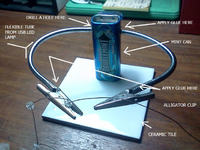tronix_geek
Newbie level 3

Dear all,
I am new to this forum. Please forgive me if my doubt is tooo basic. I have none else to ask .
I am attaching two pics of the board i bought for soldering resistors , transistors etc. I am learning to solder now. I have attached both faces of the board - Soldering face & Component attaching face.
Soldering Face

Component attaching face

In my Board, the dots are not interconnected , like in a Bread Board.
My doubt is this :
I dont know how to connect one lead each of 2 resistors together on this board. Let the leads of resistor R1 go into the dots A & B & let the leads of resistor R2 go into dots C & D. After successfully soldering R1 & R2 on to the board, now i have to connect a copper cable between dots B & C for R1 & R2 to be in series.
Is it enough f i melt the solidified solder at dot B & immediately attach the cable there. Will the connection be strong ? I hold soldering iron in my right hand & the copper cable in my left -How do i apply more solder at that dot ? I simply don't get it.
Please Help me !!
I am new to this forum. Please forgive me if my doubt is tooo basic. I have none else to ask .
I am attaching two pics of the board i bought for soldering resistors , transistors etc. I am learning to solder now. I have attached both faces of the board - Soldering face & Component attaching face.
Soldering Face

Component attaching face

In my Board, the dots are not interconnected , like in a Bread Board.
My doubt is this :
I dont know how to connect one lead each of 2 resistors together on this board. Let the leads of resistor R1 go into the dots A & B & let the leads of resistor R2 go into dots C & D. After successfully soldering R1 & R2 on to the board, now i have to connect a copper cable between dots B & C for R1 & R2 to be in series.
Is it enough f i melt the solidified solder at dot B & immediately attach the cable there. Will the connection be strong ? I hold soldering iron in my right hand & the copper cable in my left -How do i apply more solder at that dot ? I simply don't get it.
Please Help me !!









